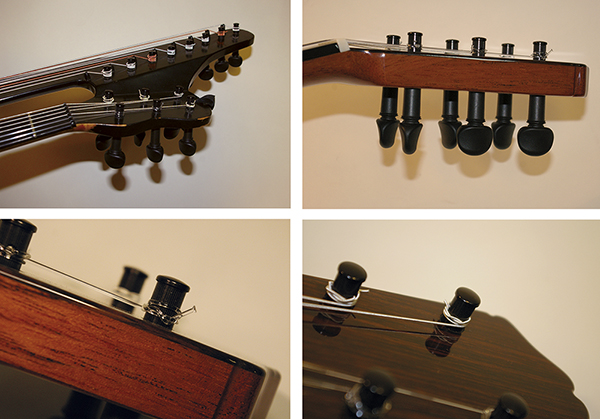
WITTNER® FINETUNE‑PEGS
MADE IN GERMANY
INSTRUCTION MANUAL
WITTNER® FINETUNE-PEGS for FLAMENCO Guitars and UKULELE
Fitting Instructions
Some important Product Features:
• Transmission ratio of 8,5 : 1 compared to an ordinary peg.
• To install our WITTNER® Finetune-Peg you need a precice Reamer with a taper of 1 : 30.
• Our WITTNER® Finetune-Pegs need not to be glued in. It's sufficient to firmly press them into the peg box.
• We don't have different pegs for the left and the right side, one WITTNER® Finetune-Peg covers everything.
Installation for the WITTNER® Finetune-Pegs:
Basic principles:
Our WITTNER® Finetune-Peg MUST NEVER be pulled by the peg button.
This is valid for the installation process and also when the peg is installed.
To remove the pegs
always push the peg out from the shaft end or tap it out from the shaft end with a composite hammer.
1. Remove the pegs you want to replace.
2. Before you gently slide the WITTNER® Finetune-Peg into the peg box to enable you to judge how much reaming of the peg box is required and before starting to ream the peg box,
make sure that the peg box is carefully cleaned from any residues (for example peg paste).
3. Then firmly push the WITTNER® Finetune-Peg into the peg box to enable you to judge how much reaming of the peg box is required.
As mentioned never pull the peg button. Allways push the WITTNER® Finetune-Peg out of the peg box from shaft end.
4. Now you can adjust the peg box to the needed size.
Please be aware that our WITTNER® Finetune-Peg is of a high-tech composite material with different static and dynamic friction than wood.
Our WITTNER® Finetune-Peg tends to slide further in the peg box (2-3 mm/0.079"-0.118") than a wooden peg of the same size.
It's therefore important to be very careful when reaming the peg box.
We recommend to first ream the peg box a little bit, then insert the peg box and push it in firmly to enable you to judge if further reaming of the peg box is necessary.
Please don't forget to push the WITTNER® Finetune-Peg out of the box from the shaft end. Don't pull at the peg button.
If necessary please repeat this process until the peg box has the correct size.
5. The peg is fitted correctly once it is pushed hard into position in the peg box.
6. In case none of the available peg-sizes fits correctly or if during the fitting process too much wood is reamed and the
WITTNER® Finetune-Peg slides a little too far into the peg box it is possible to "shim" the peg box using the old “sandpaper trick”.
This is an effective way of increasing the diameter of the WITTNER® Finetune-Pegs.
Here you find different templates to be cut out and inserted into the pegholes:
>>> PDF-DOWNLOAD: Template: How to make a smaller peg fit into a larger peghole without "rebushing"
If you use for example a regular paper of 0,1 mm thickness this causes for example an axial play/clearance of 2 - 3 mm (Taper 1:30; 30 x 0,1 mm = 3 mm).
In order to master bigger tolerances sandpaper (version 1500 or 1800) is used. The grain side should always be towards the pegholes so that the grain side is pressed into the wood.
If you use for example sandpaper, grain 1800 you can kind of "rebush" much wider holes to make our Finetune-Pegs fit very firmly and functional.
This "sandpaper" solution works quite well with our pegs, because the interface surfaces are static.
7. Now you can mount the string. The following pictures show how the string should be mounted:

The string - especially the smooth Nylon string - should generally be inter-locked/crossed since without inter-locking/crossing the smooth string might be pulled out of the WITTNER® Finetune-Peg even if there are several windings.
Not inter-locking/crossing the string would affect the stability of the tuning process.
Please make certain that the strings wind onto the spline = the part of the shaft that turns.
This is most important because if the string winds onto the shaft of the peg that does not turn it could "snag" and snap.
Please make also certain that the strings have enough room in the grooves of the nut so that they cannot wedge in order to enable the strings to follow each movement of the WITTNER® Finetune-Pegs.
In some cases the string is too long and there is too much string length to fit on the moving spline which would affect the stability of the tuning process.
If the string ist too long it should be carefully shortened.
In fact there is no need for more than 3-4 windings of the string on the moving spline.
As mentioned we recommend to inter-lock/cross the windings of the string.
When restringing we recommend you our WITTNER® Finetune-Peg Winder. It makes the process much quicker!
For more information:
>>> WITTNER® Finetune-Peg Winder - Product page

Patent:
Germany: DE 10 2007 054 312 A1
USA: USA 7,816,594 B2
China: CN 101868820
and others
<<< To the top
<<< Back to product overview

Wittner – Division of Gewa Music GmbH
D-88316 Isny Phone ++49-7562-7040
SITE NOTICE · DATA PROTECTION